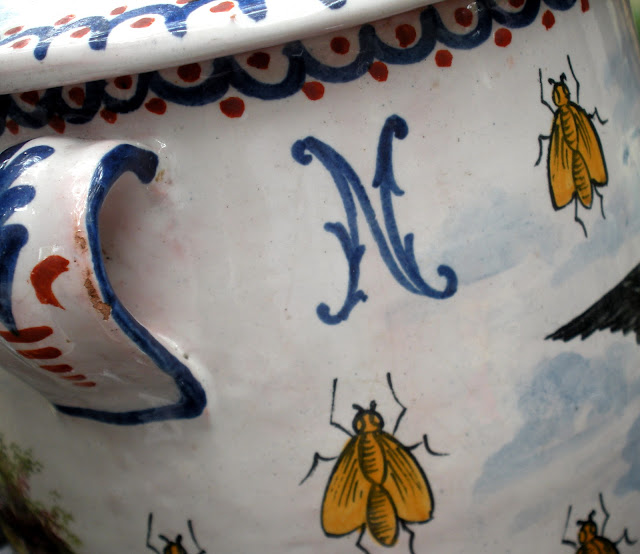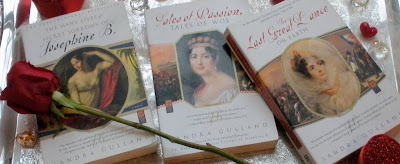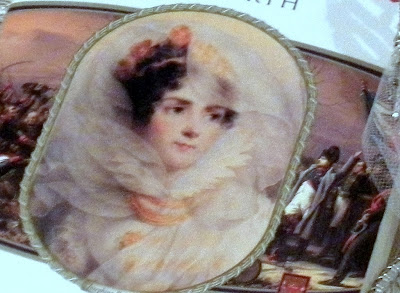Napoleon Bonaparte and Joséphine de Beauharnais
~ One of the Greatest Love Stories in History ~
Vintage Postcard, dated 1908
Napoleon and Josephine were married March 9, 1796.
It's no secret that Paris has long been my favorite
destination, and over the years I've collected
my fair share of Napoleonic memorabilia.
my fair share of Napoleonic memorabilia.
Kathryn Crisp Greeley's new book,
THE COLLECTED TABLETOP,
advocates using one's collections to set a special table.
I decided to do just that when I selected
Napoleonic Memorabilia
as my topic for a CAMEO meeting.
I'm passing along this tip for
Tutorials, Tips, and Tidbits @ Stone Gable.
When you host your next dinner party, gather up a collection
to use as a theme. I found it fun to see my pieces grouped
together, and your collection will no doubt spark conversation.
Those of you who follow HFTS might remember the post I shared here about CAMEO, a small antique club of which I'm a member.
CAMEO
Collecting Antiques and Memorabilia
and Educating Ourselves
The structure of our small group is such that each member is responsible for presenting or arranging a presentation on a topic of interest to share with the group at one of our monthly meetings.
~ Collecting Napoleonic Memorabilia ~
My topic of choice last spring.
The pottery pieces you see in the photos
are mostly French faience produced in the
last part of the 19th century or the first half of the 20th century.
Small Bust of Napoleon, CA
Dinner Plate, HenRiot Quimper
Teapot part of Garden Buddies Tea Service, unmarked
Napoleon Ivy ~ As Used By Napoleon At St. Helena ~ 1815
Wedgwood Etruria England
I only have but one demi-tasse cup and saucer in this lovely pattern, though I long to add more pieces someday. It is Kathryn Greeley's #2 choice in her Top Ten China Patterns. Now retired, this pattern was that which Napoleon used while in exile on the south Atlantic island of St. Helena.
Vintage Bronze Souvenirs of Paris Aside a
Vintage Avon Bee Skep Cologne Bottle
Vintage Letter Openers Atop 1900 Edition of L'Aiglon,
A Play In Six Acts Based On The Life Of Napoleon's Son
Performed At The Knickerbocker Theatre
New York, October 1900
Serving a light brunch, I used the opportunity to follow Karhryn Greeley's advice: "Mixing antique collections with contemporary tabletop pieces adds drama and the unexpected." With my collection as the central focus of my tables, I could easily pull select pieces to share with the group as I presented my topic.
Empire by Walbrzych, Poland,
A lovely ribbed and scalloped plate with gold verge and trim was
a thrifty Goodwill find. With a name like Empire
I thought it most appropriate in homage to Napoleon.
A lovely ribbed and scalloped plate with gold verge and trim was
a thrifty Goodwill find. With a name like Empire
I thought it most appropriate in homage to Napoleon.
The golden bee textiles are from William Sonoma.
Petite Forks by Sabre of Paris
MacKenzie-Childs Flower Market
and Courtly Check Enamel Ware
Salmon Spread with Crackers
Recipe here
Seasonal Berries and Melon
with Onion Walnut Muffins
Recipe here
The drink table featured
items with the bee motif.
items with the bee motif.
Petite French Faience Vase, CA
Napoleonic Bee Vintage Silk Fragment, c1880
Napoleonic Bee Stems,
La Rochere of France
For The Dessert Table
~ A Touch of Josephine ~
~ A Touch of Josephine ~
The stack of plates are Sarreguemines transfer ware c.1890-1922, and each feature a different Napoleonic military scene. These were ironically found on a CAMEO field trip to Fredericksburg, TX. One never knows where treasures will be discovered.
The red toleware jardiniere is a contemporary piece.
Pair of Revolutionary Commemorative Plates, PBx, c1880.
Sweet Little Souvenirs
Chateau de Fontainebleau, 2011
Chateau de Fontainebleau, 2011
Vintage Tiara ~ A Gift From My CAMEO Friends
If you enjoy historical fiction and the subject is of interest, I highly recommend reading Sandra Gulland's trilogy about Josephine. It's a new look at this fascinating character of French history.
I reviewed each book in the links below.
For those of you still with me on this
lengthy post, I offer you some sweet treats.
~ Napoleons ~
Layers of Mille-Feuille and Vanilla Cream
Topped with Fondant
Bee Sugar Cookies
Vanilla Meringue Bites
Perhaps this post will inspire you to begin a memorabilia
collection of your own on a theme that interests you.
Joining



















































































.png)






.JPG)


















.jpg)

































































